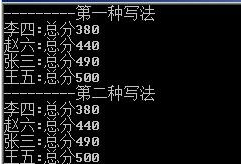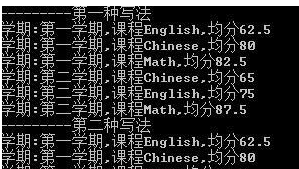Group在SQL经常使用,通常是对一个字段或者多个字段分组,求其总和,均值等。
Linq中的Groupby方法也有这种功能。具体实现看代码:
假设有如下的一个数据集:
public class StudentScore { public int ID { set; get; } public string Name { set; get; } public string Course { set; get; } public int Score { set; get; } public string Term { set; get; } } List<StudentScore> lst = new List<StudentScore>() { new StudentScore(){ID=1,Name="张三",Term="第一学期",Course="Math",Score=80}, new StudentScore(){ID=1,Name="张三",Term="第一学期",Course="Chinese",Score=90}, new StudentScore(){ID=1,Name="张三",Term="第一学期",Course="English",Score=70}, new StudentScore(){ID=2,Name="李四",Term="第一学期",Course="Math",Score=60}, new StudentScore(){ID=2,Name="李四",Term="第一学期",Course="Chinese",Score=70}, new StudentScore(){ID=2,Name="李四",Term="第一学期",Course="English",Score=30}, new StudentScore(){ID=3,Name="王五",Term="第一学期",Course="Math",Score=100}, new StudentScore(){ID=3,Name="王五",Term="第一学期",Course="Chinese",Score=80}, new StudentScore(){ID=3,Name="王五",Term="第一学期",Course="English",Score=80}, new StudentScore(){ID=4,Name="赵六",Term="第一学期",Course="Math",Score=90}, new StudentScore(){ID=4,Name="赵六",Term="第一学期",Course="Chinese",Score=80}, new StudentScore(){ID=4,Name="赵六",Term="第一学期",Course="English",Score=70}, new StudentScore(){ID=1,Name="张三",Term="第二学期",Course="Math",Score=100}, new StudentScore(){ID=1,Name="张三",Term="第二学期",Course="Chinese",Score=80}, new StudentScore(){ID=1,Name="张三",Term="第二学期",Course="English",Score=70}, new StudentScore(){ID=2,Name="李四",Term="第二学期",Course="Math",Score=90}, new StudentScore(){ID=2,Name="李四",Term="第二学期",Course="Chinese",Score=50}, new StudentScore(){ID=2,Name="李四",Term="第二学期",Course="English",Score=80}, new StudentScore(){ID=3,Name="王五",Term="第二学期",Course="Math",Score=90}, new StudentScore(){ID=3,Name="王五",Term="第二学期",Course="Chinese",Score=70}, new StudentScore(){ID=3,Name="王五",Term="第二学期",Course="English",Score=80}, new StudentScore(){ID=4,Name="赵六",Term="第二学期",Course="Math",Score=70}, new StudentScore(){ID=4,Name="赵六",Term="第二学期",Course="Chinese",Score=60}, new StudentScore(){ID=4,Name="赵六",Term="第二学期",Course="English",Score=70}, };
可以把这个数据集想象成数据库中的一个二维表格。
示例一
通常我们会把分组后得到的数据放到匿名对象中,因为分组后的数据的列不一定和原始二维表格的一致。当然要按照原有数据的格式存放也是可以的,只需select的时候采用相应的类型即可。
第一种写法很简单,只是根据下面分组。
//分组,根据姓名,统计Sum的分数,统计结果放在匿名对象中。两种写法。 //第一种写法 Console.WriteLine("---------第一种写法"); var studentSumScore_1 = (from l in lst group l by l.Name into grouped orderby grouped.Sum(m => m.Score) select new { Name = grouped.Key, Scores = grouped.Sum(m => m.Score) }).ToList(); foreach (var l in studentSumScore_1) { Console.WriteLine("{0}:总分{1}", l.Name, l.Scores); } 第二种写法和第一种其实是等价的。 //第二种写法 Console.WriteLine("---------第二种写法"); var studentSumScore_2 = lst.GroupBy(m => m.Name) .Select(k => new { Name = k.Key, Scores = k.Sum(l => l.Score) }) .OrderBy(m => m.Scores).ToList(); foreach (var l in studentSumScore_2) { Console.WriteLine("{0}:总分{1}", l.Name, l.Scores); }

示例二
当分组的字段是多个的时候,通常把这多个字段合并成一个匿名对象,然后group by这个匿名对象。
注意:groupby后将数据放到grouped这个变量中,grouped 其实是IGrouping<TKey, TElement>类型的,IGrouping<out TKey, out TElement>继承了IEnumerable<TElement>,并且多了一个属性就是Key,这个Key就是当初分组的关键字,即那些值都相同的字段,此处就是该匿名对象。可以在后续的代码中取得这个Key,便于我们编程。
orderby多个字段的时候,在SQL中是用逗号分割多个字段,在Linq中就直接多写几个orderby。
//分组,根据2个条件学期和课程,统计各科均分,统计结果放在匿名对象中。两种写法。 Console.WriteLine("---------第一种写法"); var TermAvgScore_1 = (from l in lst group l by new { Term = l.Term, Course = l.Course } into grouped orderby grouped.Average(m => m.Score) ascending orderby grouped.Key.Term descending select new { Term = grouped.Key.Term, Course = grouped.Key.Course, Scores = grouped.Average(m => m.Score) }).ToList(); foreach (var l in TermAvgScore_1) { Console.WriteLine("学期:{0},课程{1},均分{2}", l.Term, l.Course, l.Scores); } Console.WriteLine("---------第二种写法"); var TermAvgScore_2 = lst.GroupBy(m => new { Term = m.Term, Course = m.Course }) .Select(k => new { Term = k.Key.Term, Course = k.Key.Course, Scores = k.Average(m => m.Score) }) .OrderBy(l => l.Scores).OrderByDescending(l => l.Term); foreach (var l in TermAvgScore_2) { Console.WriteLine("学期:{0},课程{1},均分{2}", l.Term, l.Course, l.Scores); }

示例三
Linq中没有SQL中的Having语句,因此是采用where语句对Group后的结果过滤。
//分组,带有Having的查询,查询均分>80的学生 Console.WriteLine("---------第一种写法"); var AvgScoreGreater80_1 = (from l in lst group l by new { Name = l.Name, Term = l.Term } into grouped where grouped.Average(m => m.Score)>=80 orderby grouped.Average(m => m.Score) descending select new { Name = grouped.Key.Name, Term = grouped.Key.Term, Scores = grouped.Average(m => m.Score) }).ToList(); foreach (var l in AvgScoreGreater80_1) { Console.WriteLine("姓名:{0},学期{1},均分{2}", l.Name, l.Term, l.Scores); } Console.WriteLine("---------第二种写法"); //此写法看起来较为复杂,第一个Groupby,由于是要对多个字段分组的,因此构建一个匿名对象, 对这个匿名对象分组,分组得到的其实是一个IEnumberable<IGrouping<匿名类型,StudentScore>>这样一个类型。 Where方法接受,和返回的都同样是IEnumberable<IGrouping<匿名类型,StudentScore>>类型, 其中Where方法签名Func委托的类型也就成了Func<IGrouping<匿名类型,StudentScore>,bool>, 之前说到,IGrouping<out TKey, out TElement>继承了IEnumerable<TElement>, 因此这种类型可以有Average,Sum等方法。 var AvgScoreGreater80_2 = lst.GroupBy(l => new { Name = l.Name, Term = l.Term }) .Where(m => m.Average(x => x.Score) >= 80) .OrderByDescending(l=>l.Average(x=>x.Score)) .Select(l => new { Name = l.Key.Name, Term = l.Key.Term, Scores = l.Average(m => m.Score) }).ToList(); foreach (var l in AvgScoreGreater80_2) { Console.WriteLine("姓名:{0},学期{1},均分{2}", l.Name, l.Term, l.Scores); }

原文:http://cnn237111.blog.51cto.com/2359144/1110587
group by与order by同时使用
SELECT [col1] ,[col2],MAX([col3]) FROM [tb] GROUP BY [col1] ,[col2] ORDER BY [col1] ,[col2] ,MAX([col3])
SELECT [col1] ,[col2],MAX([col3]) AS [col3] FROM [tb] GROUP BY [col1] ,[col2] ORDER BY [col1] ,[col2] ,[col3]
SELECT [col1] ,[col2] FROM [tb] GROUP BY [col1] ,[col2] ,[col3] ORDER BY [col1] ,[col2] ,[col3]
撇开聚合函数不说,select后面的列+order by后面的列必须在group by里面(sqlserver 要求,mysql 貌似没这么要求),也就是说select和order by 后面的列是group by列的子集,
而select 和order by直接没什么直接关系。
1.简单形式: var q = from p in db.Products group p by p.CategoryID into g select g; 语句描述:Linq使用Group By按CategoryID划分产品。 说明:from p in db.Products 表示从表中将产品对象取出来。group p by p.CategoryID into g表示对p按CategoryID字段归类。
其结果命名为g,一旦重新命名,p的作用域就结束了,所以,最后select时,只能select g。 2.最大值 var q = from p in db.Products group p by p.CategoryID into g select new { g.Key, MaxPrice = g.Max(p => p.UnitPrice) }; 语句描述:Linq使用Group By和Max查找每个CategoryID的最高单价。 说明:先按CategoryID归类,判断各个分类产品中单价最大的Products。取出CategoryID值,并把UnitPrice值赋给MaxPrice。 3.最小值 var q = from p in db.Products group p by p.CategoryID into g select new { g.Key, MinPrice = g.Min(p => p.UnitPrice) }; 语句描述:Linq使用Group By和Min查找每个CategoryID的最低单价。 说明:先按CategoryID归类,判断各个分类产品中单价最小的Products。取出CategoryID值,并把UnitPrice值赋给MinPrice。 4.平均值 var q = from p in db.Products group p by p.CategoryID into g select new { g.Key, AveragePrice = g.Average(p => p.UnitPrice) }; 语句描述:Linq使用Group By和Average得到每个CategoryID的平均单价。 说明:先按CategoryID归类,取出CategoryID值和各个分类产品中单价的平均值。 5.求和 var q = from p in db.Products group p by p.CategoryID into g select new { g.Key, TotalPrice = g.Sum(p => p.UnitPrice) };
var allPropertyList = PropertyList.GroupBy( x => new { x.Type, x.Code}, (key, values) => { var propertyEntities = values as PropertyEntity[] ?? values.ToArray(); return new PropertyEntity() { Type= key.Type, GoodsCode = key.GoodsCode, Code = PropertyEntities.FirstOrDefault()?.Code }; }).ToList();
var param = models.GroupBy(m => m.Key, (key, values) => new { StockId = key, StockOutAmount = values.Sum(g => g.Value), ModifyBy = user.Name });
注意:
使用group by的SQL语句中,select中返回的字段,必须满足以下两个条件之一:
1.包含在group by语句的后面,作为分组的依据;
2.这些字段包含在聚合函数中
